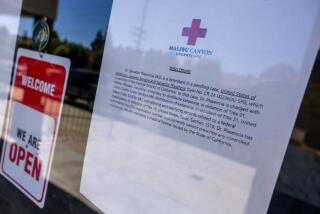Autopsy Limits Fail to Detect Rare Poisons
- Share via
There are 8 million chemical compounds on Earth, yet even the most sophisticated coroner’s lab tests for no more than a few hundred of them. So perhaps it should come as no surprise that when 300-pound Burbank mortician Timothy Waters died three years ago, medical examiners missed the real cause of death--poison.
Waters was thought to have died from a heart attack on April 8, 1985. But new tests discovered oleander, a potent poison taken from the brightly flowered plant common in California, in his tissue.
Under suspicion of poisoning Waters is David Sconce, a 32-year-old Pasadena funeral home operator already in jail on 67 felony and misdemeanor charges ranging from mutilating corpses to selling body parts.
Though the modern forensics laboratory has at its disposal a barrage of testing devices, from gas chromatographs to mass spectrometers, science didn’t focus suspicion on Sconce, who has not been charged in the crime. His bragging about his alleged crime did.
Testing Limitations
The case is raising questions about how a man could be poisoned, vomit for two days before dying, and be buried without anyone suspecting foul play. The reasons lie in both the limits of the laboratory and the limits on taxpayer dollars that finance medical investigations reaching into the grave.
Medical examiners order autopsies in about a third of the deaths that come to them, said Ventura County Examiner Dr. F. Warren Lovell. In still fewer cases, they request tests to determine the presence of toxins. But even if every test had been done in Waters’ case, experts agree, the cause of death probably still would have gone undetected.
“Oleander is not high on the list of common poisons,” said Dr. Fredric Rieders, director of National Medical Services in Philadelphia, the laboratory that finally isolated the oleander in Waters’ tissues. “As a matter of fact, it’s probably nowhere on most lists” of chemicals to be tested in a toxicological analysis.
Although each coroner’s office is different, Rieders said, a common practice in a death of uncertain cause is to do a preliminary analysis, looking for 100 or so compounds, including alcohol, such drugs as cocaine, amphetamines, barbiturates and Quaaludes, and common poisons, such as arsenic and strychnine. If those tests are negative, the examiner may order detailed tests on a gas chromatograph for the presence of certain metals and other subtle compounds.
“That is a very, very comprehensive analysis,” Rieders said. Yet it is still incomplete.
“If I were to sit down and go through the lists and find all the different compounds people die of, I would probably generate a list in the thousands,” one California medical examiner said. “But the gas chromatograph picks up less than 50% of those.”
If those tests fail, “then the hunt starts,” Rieders said.
Game of Roulette
The hunt is actually more like a game of roulette in which researchers, relying on intuition or suspicion, bet everything on a test for a specific compound. Oleander, for instance, mimics the effects of digitalis, a drug designed to make the heart’s contractions stronger. Too much, however, prevents the heart from relaxing again after a contraction.
Testing for the presence of digitalis would have produced a sign that led to oleander. But since Waters was not taking any heart medication, there was little reason to suspect it. “None of the procedures I have mentioned is likely to detect digitalis or oleander,” Rieders said.
When researchers take to the chemical trail, they must be willing to trust their instincts and be confident in the backing of superiors, because the investigation can be expensive and time-consuming. “It can bring an entire lab to a halt,” Rieders said.
The analysis for oleander in Waters’ case cost $1,800 and ultimately involved two outside labs.
The best evidence may lie in symptoms before death or in the condition of the body after death. Some poisons leave an odor that is detectable when the body is opened. Waters was ill for two days before he died, which might have raised questions about what the dead man had consumed in his final hours. There was testimony at a court hearing that poison had been dumped into his drink at a restaurant.
Even though he was only 24, Waters’ obesity was compelling evidence of a potential heart problem. Heart attacks can be accompanied by vomiting, Rieders said.
Medical examiners say cases may trouble them for years. From time to time, an idea may pop into their heads, and they will run more tests. Tissues from an autopsy are routinely saved so future tests can be done. Lovell said Ventura County saves blood for five years in all autopsies, including ones such as the Waters case, where foul play was not suspected. This is a practice common in the profession.
After reports recently reached police that Sconce had been bragging about the killing, Lovell renewed the investigation. Because he suspected that poison was involved, he sent body samples to a laboratory in Foster City with instructions to test for arsenic, which kills slowly. That test was negative.
Casting about for another idea, Lovell had an epiphany. He suggested that oleander might be a possibility.
In contrast to cinematic portrayals, such flashes of insight by a medical examiner are wrong as often as they are right. When they are right, however, it can make for a forensics success story so dramatic that it hits the front pages and the evening news.
Originally, the Waters case did not seem like a very good candidate for medical detective work. The man was greatly overweight, and when the body was opened up by Dr. John Holloway, who performed the autopsy, it was found to have a fatty liver, often associated with excessive drinking.
‘Cardiac Type of Death’
“It looked like a cardiac type of death,” said Holloway, who now works in Bakersfield. Holloway never ordered backup toxicological tests, and Rieders said he can’t blame him.
“It was perfectly reasonable not to do anything more” than an autopsy, he said.
Looking back on it, Lovell, the current Ventura County medical examiner, said there was non-medical evidence that should have alerted county investigators. Two weeks before his death, Waters had been physically attacked, indicating he had enemies.
“There should have been more suspicion,” Lovell said.
More to Read
Sign up for Essential California
The most important California stories and recommendations in your inbox every morning.
You may occasionally receive promotional content from the Los Angeles Times.










